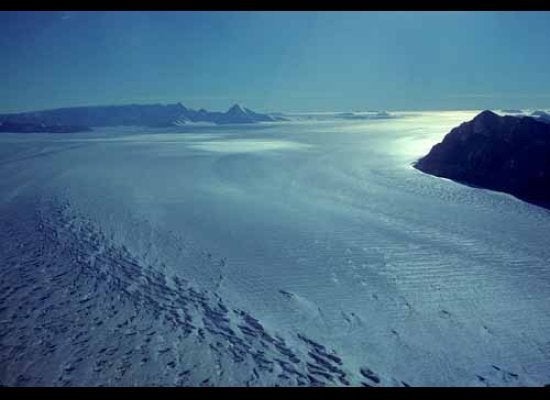Glaciers are among the most impressive of Mother Nature's creations, flowing down valleys like mighty rivers. However, unlike rivers in which the water is a liquid (noncrystalline), glacier ice flows as a ductile or plastic solid (crystalline, albeit in motion). Flow rates for the major outlet glaciers of the Transantarctic Mountains have been measured in the range of two to six feet per day. At the scale of the glacier, the movement is steady and uniform, but at the scale of individual crystals of ice, the frantic migration of molecules from spots of higher to lower pressure causes the solid crystals of ice to recrystallize and change their shapes.
One of the characteristics of a ductile solid like ice is that, if the rate at which it flows is too rapid, it will lose its coherency and break. The ice is then said to be behaving as a brittle solid. Because the ductility of ice increases with depth due to its overlying weight, ice is most brittle at the surface. As brittle fractures open they propagate downward, producing gashes in the glacier that are known as crevasses. Crevasses open where a glacier accelerates and stretches, and are oriented perpendicular to the direction of maximum extension. Where glaciers make sharp turns, flow over ridges, or drop from hanging valleys, the geometry of the crevasses may become chaotic, with huge seracs (ice blocks) tumbling down ice falls, stationary in human time.
Crevasses are like rattlesnakes -- not a problem if you know where they are, but if you don't see them, they can catch you by surprise. The danger of a crevasse is that it may be covered by a bridge that conceals a yawning space below. A crevasse opens in tiny increments, with each brittle fracture separating the ice by a millimeter or so. As the crack opens, blowing snow sifts down into it, sealing up the gap and building a bridge that widens at the same pace as the opening of the crevasse. The bridge is typically thinnest at the edges and droops in the middle. To detect subtle crevasses, you need to look for faint linear offsets in the snow, and, if you find one, probe it with an ice axe or a pole to see how thin and wide it is. Then you must decide whether to cross or go around.
I first descended into a crevasse in 1970 on my first trip to Antarctica. It was about a mile out from our helicopter camp on McGregor Glacier deep within the Transantarctic Mountains. On an overcast day, I was belayed on a rope from above and climbed down a "crevasse ladder" -- a flexible, wired ladder for crevasse rescue -- into a world of deep, soft, and subtle gray. The crevasse was narrow and not more than six feet wide at the top. The walls reached twenty feet below to an irregular surface of blocks that had dropped years before from the underside of the bridge that we had chopped open for our fun. The paired walls undulated gracefully in symmetrical curves that transcended simple math, then played off to the right into a slightly larger room that pinched to nothing at its bottom. I wedged my foot across the bottom of the crevasse and looked back up. I was surrounded by a sculpture illuminated from without. The walls were translucent gray, strewn through with layers of fine, white bubbles, configured in blocks that had been broken and then fused into a brittle/ductile mish-mash of rehealed ice. I felt as if I were underwater -- it was rapture.
I was hooked. Unless there was a particularly good 16mm movie showing at the camp that night, several of us would hike over to the crevasse field to fool around in our newfound world within the glacier. When the sun was shining, the grayness that I had experienced in my first crevasse was transcended by pervasive blue, pale and bright near thin spots in an overhanging bridge, dark and rich, deep down in. The blue color is due to absorption of light in the red portion of the visible spectrum by molecules of water. It is the same in water and in ice. Crevassing is indeed an underwater experience. The deeper down one goes, the purer becomes the blue.
One of the delightful surprises in crevasses is the formation of ice crystals on the underside of their bridges. Created by direct precipitation of water molecules from the still air of the crevasse interior, these hoar crystals are hexagonal in form with delicate, hoppered steps. Brush them with your parka and they come tinkling down. Place one on your tongue and feel it melt away. Taste the freshness. These are the hidden gems in the secret world of crevasses.
